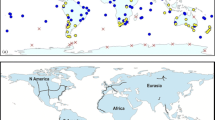Abstract
Global Shuttle Radar Topography Mission (SRTM) data products have been widely used in Earth Sciences without an estimation of their accuracy and reliability even though large outliers exist in them. The global 1 arc-sec, 30 m resolution, SRTM C-Band (C-30) data collected in February 2000 has been recently released (2014–2015) outside North America. We present the first global assessment of the vertical accuracy of C-30 data using Ground Control Points (GCPs) from the International GNSS Service (IGS) Network of high-precision static fiducial stations that define the International Terrestrial Reference Frame (ITRF). Large outliers (height error ranging from –1285 to 2306 m) were present in the C-30 dataset and 14% of the data were removed to reduce the root mean square error (RMSE) of the dataset from ∼187 to 10.3 m which is close to the SRTM goal of an absolute vertical accuracy of RMSE ∼10 m. Globally, for outlier-filtered data from 287 GCPs, the error or difference between IGS and SRTM heights exhibited a non-normal distribution with a mean and standard error of 6.5 ± 0.5 m. Continent-wise, only Australia, North and South America complied with the SRTM goal. At stations where all the X- and C-Band SRTM data were present, the RMSE of the outlier-filtered C-30 data was 11.7 m. However, the RMSE of outlier-included dataset where C- and X-Band data were present was ∼233 m. The results suggest that the SRTM data must only be used after regional accuracy analysis and removal of outliers. If used raw, they may produce results that are statistically insignificant with RMSE in 100s of meters.






Similar content being viewed by others
References
Bamler R 1999 The SRTM mission: A world-wide 30 m resolution DEM from SAR interferometry in 11 days; In: Photogrammetric Week (eds) R Fritsch and R Spiller, pp. 145–154.
Dow J M, Neilan R E and Rizos C 2009 The International GNSS Service in a changing landscape of Global Navigation Satellite; J. Geodesy 83 (3–4) 191–198.
Farr T G and Kobrick M 2000 Shuttle radar topography mission produces a wealth of data; Trans. Am. Geophys. Union 81 583–585.
Farr T G, Rosen P A, Caro E, Crippen R, Duren R, Hensley S, Kobrick M, Paller M, Rodriguez E, Roth L, Seal D, Shaffer S, Shimada J, Umland J, Werner M, Oskin M, Burbank M and Alsdorf D 2007 The Shuttle Radar Topography Mission; Rev. Geophys. 45 RG2004. doi:10.1029/2005RG000183.
JPL Shuttle Radar Topography Mission 2009 Technical Fact Sheet; http://www2.jpl.nasa.gov/srtm/index.html.
Kolecka N and Kozak J 2014 Assessment of the accuracy of SRTM C- and X-Band high mountain elevation data: A case study of the Polish Tatra Mountains; Pure Appl. Geophys., doi:10.1007/s00024-013-0695-5.
Mouratidis A, Briole P and Katsambalos K 2010 SRTM 300 DEM (versions 1, 2, 3, 4) validation by means of extensive kinematic GPS measurements: A case study from North Greece; Int. J. Remote Sens. 31 (23) 6205–6222.
Mukul Manas, Srivastava V and Mukul Malay 2015 Analysis of the accuracy of Shuttle Radar Topography Mission (SRTM) height models using International Global Navigation Satellite System Service (IGS) Network; J. Earth Syst. Sci. 124 (6) 1343–1357.
Rabus B, Eineder M, Am R. and Bamler R 2004 The shuttle radar topography mission – a new class of digital elevation models acquired by space borne radar; J. Photogramm. Remote Sens. 57 241–262.
Razali N M and Wah Y B 2011 Power comparisons of Shapiro–Wilk, Kolmogorov–Smirnov, Lilliefors and Anderson–Darling test; J. Stat. Model. Anal. 2 (1) 21–33.
Rodriguez E, Morris C S and Belz J E 2006 A global assessment of the SRTM performance; Photogramm. Eng. Remote Sens. 72 249–260.
Rodriguez E, Morris C S, Belz J E, Chapin E C, Martin J M and Daffer W 2005 An assessment of the SRTM topographic products; Technical Report JPLD-31639 Pasadena California: Jet Propulsion Laboratory, 143p.
Shapiro S S and Wilk M B 1965 An analysis of variance test for normality (complete samples); Biometrika 52 (3/4) 591–611.
USGS 2005 Shuttle radar topography mission; http://srtm.usgs.gov.
Varga M and Tomisla B 2015 Accuracy validation and comparison of global digital elevation models over Croatia; Int. J. Remote Sens. 36 (1) 170–189.
Wechsler S P 2003 Perceptions of digital elevation model uncertainty by DEM users; URISA-WASHINGTON DC 15 (2) 57–64.
Werner M 2001 Shuttle radar topography mission (SRTM), mission overview; J. Telecommun. (Frequenz) 55 75–79.
Zimmerman D W 1994 A note on the influence of outliers on parametric and nonparametric tests; J. General Psychology 121 (4) 391–401.
Zimmerman D W 1995 Increasing the power of nonparametric tests by detecting and downweighting outliers; J. Experimental Education 64 (1) 71–78.
Zimmerman D W 1998 Invalidation of parametric and nonparametric statistical tests by concurrent violation of two assumptions; J. Experimental Education 67 (1) 55–68.
Acknowledgements
This is an IITBESCDL/001/2015 publication. The work was funded by the Ministry of Earth Sciences India, Grant No. MoES/16/01/09-RDEAS and Department of Science and Technology India, Grant No. SR/S4/ES-415/2009 to Malay. VS acknowledges IITB for the Teaching Assistantship in the Department of Earth Sciences. Critical reviews by two anonymous reviewers and comments of the JESS handling editor helped to significantly improve the quality of this paper. We are grateful to the editorial staff of JESS for painstakingly putting this paper together. We benefited from discussions with Sridevi Jade, D Ramakrishnan and Rishikesh Bharti.
Author information
Authors and Affiliations
Corresponding author
Additional information
Corresponding editor: Pradeep Kumar Thapliyal
Electronic supplementary material
Below is the link to the electronic supplementary material.
Rights and permissions
About this article
Cite this article
Mukul, M., Srivastava, V. & Mukul, M. Accuracy analysis of the 2014–2015 Global Shuttle Radar Topography Mission (SRTM) 1 arc-sec C-Band height model using International Global Navigation Satellite System Service (IGS) Network. J Earth Syst Sci 125, 909–917 (2016). https://doi.org/10.1007/s12040-016-0716-8
Received:
Revised:
Accepted:
Published:
Issue Date:
DOI: https://doi.org/10.1007/s12040-016-0716-8




